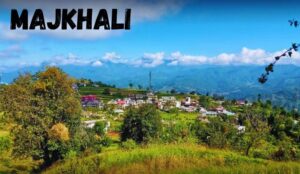Uttarakhand, a realm bathed in celestial resonance, stands as a haven of spiritual tourism. This sacred land weaves together a vibrant tapestry of temples, ranging from mythological epics to historical legacies. Aptly titled as ‘DEVBHOOMI,’ the land of gods, Uttarakhand unveils a realm where spirituality intertwines with history, inviting pilgrims and travelers to explore its revered shrines.
Unveiling Adi Badri’s Essence
A Prelude to Splendor – The Setting and Legacy Situated a mere 17 kilometers beyond the enchanting Karnprayag, Adi Badri occupies a pivotal position in the constellation of Sapta Badri temples. As a part of the Char Dham Yatra Package in Uttarakhand, it beckons pilgrims and travelers alike to explore its sacred grounds. The name ‘Adi Badri’ draws its origins from the Badrikshetra, where ‘Badri’ pays homage to Lord Vishnu, epitomizing the seven holy shrines of the deity. It’s within the Badrikshetra that Adi Badri thrives, encompassing spiritual allure and architectural grandeur.
Guardian of Heritage – Facts and Legends The splendor of Adi Badri resides in its ensemble of 16 temples, with the central shrine dedicated to Narayan, a revered form of Lord Vishnu. Echoing whispers of history suggest that these sacred halls were erected during the Gupta period (5th – 8th century), reflecting an era of profound artistry and devotion. Positioned a short 3 kilometers away, the Chandpur fort adds an air of mystique, a testimony to the Parmar kings of Garhwal. Adi Badri’s transition to Yog Badri upon Badrinath’s shift to Bhavishya Badri hints at a celestial dance of destiny and devotion.
Unraveling the Mystique
Sanctuary in Adversity – Significance Beyond Measure Adi Badri holds an irreplaceable significance as the divine refuge when the Badrinath temple’s doors close due to nature’s extremities. Devotees converge here, their hearts brimming with devotion for Lord Vishnu, seeking solace in His benevolent presence. Encased within the sanctum, an exquisite image of Lord Vishnu, sculpted from black stone, stands tall at 1 meter, a testament to timeless craftsmanship.
A Tapestry of Time – Tracing the Historical Threads The annals of history intertwine with Adi Badri, attributing its creation to the profound efforts of Adi Shankaracharya during the Gupta period. Guided by an unwavering vision to propagate Hinduism across lands both accessible and remote, he set the stage for the Sapta Badri pilgrimage circuit. According to ancient texts, Adi Badri witnessed Vishnu’s residence in Satyug, Treta, and Dwapar, with His eventual migration to Badrinath in Kalyug. Maharishi Ved Vyas, the luminous sage, orchestrated the division of the Vedas within these sacred confines, birthing Rigveda, Samveda, Yajurveda, and Atharvaveda.
Darshan Timings of Adi Badri Temple In Morning
- In Morning, Timings are 5 AM to 12 PM
- In Evening – Timings are from 2 PM to 9 PM
- Entry Fee – Entry fee is free in the Adi Badri Temple
- Dress Code – Traditional wear is the dress code
- Exploration Time – It is estimated that the exploration timings is around 2 hr.
- Opening and Closing Timings of Adi Badri – It is closed from 16 December to 14 January every year. This temple is closed for about a month every year.
Architectural Marvels Unveiled
A Symphony of Stone – Architectural Marvels Within the temple complex, a canvas of architectural brilliance unfolds. Spanning an expanse of 14 meters by 30 meters, the intricate web of temples reaches for the skies, with heights ranging from 2 to 6 meters. The centerpiece, Lord Vishnu’s sanctum, reigns supreme on an elevated platform. A resplendent black stone idol of Lord Vishnu, adorned with a mace, lotus, and chakra, commands reverence and awe. Adjacent temples, dedicated to Shiva and Mantra Devi, share the premises with a sacred Kund, a revered source of the Saraswati river.
A Tapestry of Festivals
Celebrations in Devotion – Festivals at Adi Badri Adi Badri pulsates with fervor during key festivals, embodying the tapestry of Hindu traditions. The rhythm of devotion reverberates during Krishna Janmashtmi, an ode to Lord Krishna’s birth, celebrated with unwavering devotion. Makar Sankranti illuminates the skies and hearts, marking the Sun’s journey into Capricorn, a harbinger of lengthening days. Adi Badri becomes a stage for vibrant festivities, vibrant colors, and timeless rituals.
Embarking on the Pilgrimage
Journey to Adi Badri – A Pilgrim’s Path Embarking on a pilgrimage to Adi Badri unveils a myriad of routes. Jolly Grant Airport in Dehradun, at a distance of 206.7 kilometers, extends its welcoming embrace to seekers of divinity. For those drawn to the railway, Rishikesh and Haridwar stand as gateways, stationed 189.3 and 212.8 kilometers away, respectively. The road weaves its story through the ISBT Kashmere Gate, connecting travelers to Rishikesh, where taxis and state transport buses become companions on the final leg to Chamoli district.
Sanctuaries of Rest
Nurturing the Traveler – Accommodations Near Adi Badri As the day draws to a close, weary travelers find solace in the embrace of nearby sanctuaries. Hotel Sudarshan Palace welcomes guests with open arms, offering respite within its garden-adorned confines. Hotel Kuber Annex extends a nurturing hand, with comforts ranging from room service to rejuvenating massages. Hotel Heaven stands as a guardian of well-being, ready to cater to every need, including medical emergencies and healing touch.
Exploring the Sapta Badri Odyssey
Sapta Badri Chronicles – Beyond Adi Badri Beyond Adi Badri, a celestial journey through the Sapta Badri temples beckons. Vriddha Badri, the third jewel, witnessed Adi Shankaracharya’s worship, heralding Badrinath’s consecration. Bhavishya Badri, the fourth wonder, harbors the promise of Lord Badri’s future abode, a testament to divine foresight. Yogadhyan Badri, the fifth sanctum, resonates with the Pandavas’ legacy, as Dhyan Badri, the sixth gem, cradles a meditative Lord Vishnu. Ardha Badri, the final destination, holds a miniature Vishnu idol, inviting reverence and reflection.
In the symphony of temples that comprise the Sapta Badri circuit, Adi Badri remains an unassuming yet resplendent note, weaving together history, devotion, and architectural prowess. As the winds of time continue to dance through its hallowed halls, Adi Badri stands as a sentinel of spirituality, a guardian of heritage, and an eternal source of inspiration.
Mythological Enchantment of Adi Badri
The Abode of Lord Vishnu Across Ages
In the epochs of Satyug, Treta, and Dwapar, Adi Badri cradled the divine presence of Lord Vishnu. As Kalyug unfurled its mantle, Lord Vishnu journeyed to Badrinath, thus bestowing the name “Adi Badri.” This sacred site also resonates with the aura of Maha Rishi Ved Vyas, who scripted the Shri Mad Bhagwat Puran within its hallowed grounds. A profound mythological thread weaves through Adi Badri, where Vedas were divided, and the Saraswati river found its genesis.
Celebrations of Devotion: Festivals at Adi Badri
Krishna Janmashtmi – Honoring Lord Krishna’s Birth
The jubilant echoes of Krishna Janmashtmi reverberate within Adi Badri, celebrating the divine advent of Lord Krishna. Pilgrims unite in joyful devotion, embracing the festival’s spirited essence.
Makar Sankranti – A January Festival of Solar Reverence
Adi Badri dons a festive cloak during Makar Sankranti, a celebration that pays homage to the Sun God. This January festival marks a celestial transition as the Sun ventures into Capricorn, heralding the gradual elongation of daylight.
Optimal Time to Embark on the Adi Badri Journey
Adi Badri unveils its splendor most enchantingly during the months of May to June and September to October. These windows of time offer gentle weather and tranquil ambiance, making them ideal for a sojourn of spiritual exploration. Winter veils the hills in a glistening quilt of snow, while challenges such as sub-zero temperatures and potential slides deter the adventurous.
Unveiling the Sanctum: Darshan Timings and More
The sanctum doors of Adi Badri swing open to devotees from 5 AM to 12 PM in the morning and from 2 PM to 9 PM in the evening. With an ethos of inclusivity, entry to Adi Badri is unburdened by an entry fee. A traditional dress code graces the temple, bestowing an air of reverence upon the sacred space. An estimated exploration time of approximately 2 hours invites visitors to immerse themselves in its spiritual embrace. Yet, during the window from 16 December to 14 January, Adi Badri’s doors remain closed, as the temple rests in reverent hibernation.
Navigating the Path: The Location of Adi Badri Temple
Adi Badri resides in the embrace of Chamoli, Garhwal, serving as a testament to architectural grandeur and spiritual devotion. Situated a mere 18 kilometers from Karanprayag along the Ranikhet road, it finds its place near NH-109, adjacent to the GMVN tourist lodge and SBI Bank. The journey from the State Bank of India on Badrinath road, Karanprayag, spans 20.8 kilometers and unfurls over 39 minutes of travel time.
The Char Dham Odyssey: Adi Badri and the Spiritual Sojourn
Adi Badri’s allure intertwines harmoniously with the grandeur of the Char Dham Yatra. As a jewel within the Panch Badri constellation – which includes Badrinath, Bhavishya Badri, Yogdhyan Badri, and Vridh Badri – Adi Badri invites pilgrims to grace its sacred precincts en route to the revered Badrinath.
Charting the Journey: How to Reach Adi Badri Temple
Adi Badri extends its embrace to seekers through various pathways:
Nearest Airport: Jolly Grant Airport, Dehradun
Approximately 210 kilometers from Adi Badri, the Jolly Grant Airport in Dehradun extends its wings to travelers. Taxis and bus services facilitate the onward journey to Adi Badri.
Nearest Train Station: Rishikesh
Rishikesh, nestled around 192 kilometers from Adi Badri, stands as the closest railway station. A tapestry of taxis and buses weaves the final threads of the pilgrimage, connecting Rishikesh to the spiritual haven of Adi Badri.
Roadways and the Enchanting Karanprayag Road
Adi Badri lies in proximity to the Karanprayag road, a mere 19 kilometers away. This motorable road weaves an intricate web, linking Adi Badri to the enchanting destinations of Ranikhet, Nainital, and Ramnagar. Travelers embarking from Delhi can traverse the route that spans Delhi to Haridwar to Rishikesh to Devprayag to Srinagar to Rudraprayag to Karanprayag and, finally, to Adi Badri.
Restful Havens: Places to Stay in Adi Badri
Nestled amidst the embrace of nature, several splendid accommodations await near Adi Badri:
Hotel Sudarshan Palace – A Garden of Tranquility
This hotel boasts a serene garden area and convenient parking facilities. Amenities such as comfortable beds, bottled drinking water, access to a common balcony, hot water, and toiletries ensure a restful stay.
Hotel Kuber Annex – Where Comfort Meets Serenity
With services ranging from room assistance to power backup, this hotel creates a haven of comfort. The availability of massage services adds an element of relaxation, while a helicopter booking facility invites a touch of luxury.
Hotel Heaven – A Gateway to Well-Being
With parking facilities and telephone services, Hotel Heaven stands as a bastion of guest comfort. Its dedicated team ensures the fulfillment of every need, including emergent medical requirements.
Epilogue
Adi Badri emerges as a tapestry of history, devotion, and architectural marvel, inviting pilgrims to embark on a spiritual odyssey. Its mythological resonance, vibrant festivals, and alignment within the Char Dham Yatra highlight its significance. As travelers and devotees traverse its sacred precincts, Adi Badri stands as an enduring testament to divinity’s abode, etching its name in the annals of spiritual devotion.
Frequently Asked Questions (FAQs) About Adi Badri
What is Adi Badri, and where is it located?
- Adi Badri is a renowned temple complex dedicated to Lord Vishnu, situated at the confluence of the Pindar and Alaknanda rivers in Chamoli district, Uttarakhand.
How does Adi Badri connect to the Sapta Badri pilgrimage circuit?
- Adi Badri is the second temple complex among the revered “Sapta Badri” (Seven Badri) temples, an integral part of the Char Dham Yatra package in Uttarakhand.
Why is it called “Adi Badri”?
- “Adi Badri” translates to “ancient Badri,” signifying its historical and mythological significance as the original abode of Lord Vishnu before he moved to Badrinath.
How does Adi Badri feature in Hindu mythology?
- Adi Badri is believed to have housed Lord Vishnu during different ages, making it a sacred site where devotees seek his blessings and connect with the divine.
What is the connection between Adi Badri and the Pandavas from the Mahabharata?
- According to legends, the Pandavas visited Adi Badri during their pilgrimage after relinquishing their kingdom, seeking solace and blessings.
What role did Adi Badri play in the writing of ancient texts?
- Adi Badri is believed to be the site where Maha Rishi VedVyas wrote parts of the Shri Mad Bhagwat Puran and divided the Vedas into different categories.
Conclusion
In the heart of the Himalayas, where rivers converge and legends intertwine, Adi Badri emerges as a beacon of devotion and history. Its stone spires reach for the skies, echoing with the chants of pilgrims who seek solace in its sacred embrace. As we unravel the layers





